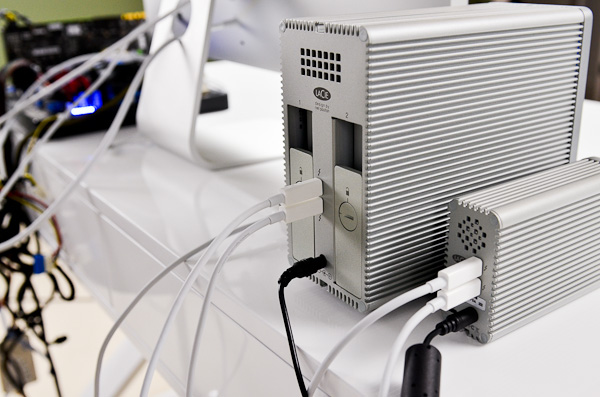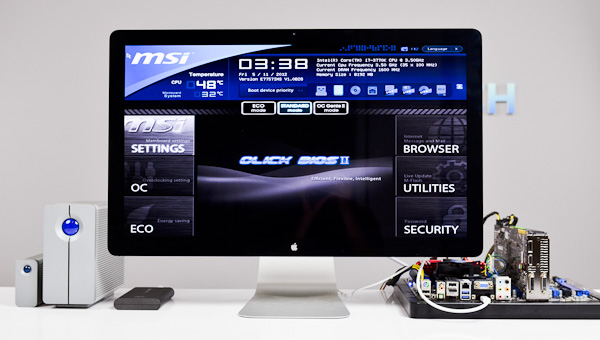A First Look at Thunderbolt on Windows with MSI's Z77A-GD80
by Anand Lal Shimpi on May 11, 2012 1:32 PM EST- Posted in
- Motherboards
- CPUs
- Intel
- MSI
- Thunderbolt
The Storage Devices & Performance
Other than Apple's Thunderbolt Display, every other TB device we've tested has been some sort of storage device. In my lab I've got Promise's Pegasus R6, LaCie's 2big and Little Big Disk (SSD), Seagate's GoFlex Thunderbolt adapter and Elgato's Thunderbolt SSD. With the exception of the Pegasus R6, which currently lacks Windows drivers, all of the storage devices I tested worked with MSI's Z77A-GD80 under Windows. Although there are workarounds for getting the Pegasus up and running under Windows, I encountered a number of hangs and general system unhappiness whenever I tried them on this platform. I suspect this has something to do with why Promise has yet to officially release Windows drivers for the Pegasus.
The rest of the storage devices, as you would expect, just worked. I didn't need to install any drivers as all of their internal controllers had native support under Windows 7. Again, I couldn't hot plug any of these devices once Windows was running - all of them had to be present at boot.
Just as I've seen under OS X, with complex Thunderbolt chains you'll sometimes have a device that hangs in the chain and prevents some or all TB devices from working. I did encounter this behavior more frequently under Windows than I did under OS X. Keep in mind that every single Thunderbolt device on the market today was pretty much developed and tested against Macs, it's going to be a little while before we get perfect behavior under Windows. We don't even have perfect behavior under OS X yet either. My hope is that as more platforms ship with Thunderbolt support, and as we get more Thunderbolt devices, compatibility and behavior validation will both improve. I've also heard that the early Thunderbolt controllers were more finicky than Cactus Ridge, so it's possible that newer TB devices that come out this year will just inherently be better behaved. This is purely hearsay however, I don't have any hard evidence to back it up.
Update: Intel tells us that an updated Pegasus driver is in the works that will address the issues we've seen. Other finicky behavior is also expected to be addressed through the Thunderbolt on Windows certification process.
Since I couldn't get the Pegasus working, I had to resort to combining a bunch of my other Thunderbolt storage devices to measure performance. I created a chain combining LaCie's 2big, the SSD Little Big Disk and Elgato's Thunderbolt SSD along with Apple's Thunderbolt Display. I ran a 128KB sequential read test at a queue depth of 32 across all of the drives, while pushing the Thunderbolt Display at its native 2560 x 1440 resolution:
The best I ever got under OS X was 8Gbps using four SandForce SSDs in the Promise Pegasus. At 7Gbps using a far less elegant setup, this isn't bad at all. Keep in mind that while we're reading at 7Gbps, the GD80 was also using around 7Gbps of bandwidth to drive the Thunderbolt Display at 2560 x 1440. Total available bandwidth for a single-port Thunderbolt device is 20Gbps bi-directional (40Gbps total), so there's still additional headroom available.
Moving Forward
MSI's Z77A-GD80 finally brings Thunderbolt to Windows desktops. With a few exceptions, the experience is quite similar to OS X. The major differences are that some devices clearly need more compatibility testing with these new platforms, and that you can't hot plug Thunderbolt devices under Windows. The former is solvable given additional time, while the latter can be more annoying in the long run if a workaround isn't found. For a single, high-speed storage device under Windows, USB 3.0 is going to be the simplest route. It's only when you want to start pushing even more bandwidth and/or add a display into the mix that Thunderbolt becomes your only solution.
Thunderbolt's functionality otherwise looks very similar under Windows as it does under OS X. The interface doesn't require any specific drivers and in the best conditions it just works. Thunderbolt's behavior remains quite finicky however, even more so under Windows. You'll want to wait for either the next generation of Thunderbolt devices or for the current device vendors to get some more time validating their Thunderbolt products on Windows platforms. Given that the first Thunderbolt equipped PC motherboards haven't even shipped yet, you've got some time.
Update: Intel has informed us that we will see updated drivers for Windows certified Thunderbolt devices that will enable hot plugging under Windows. Intel further informed us that MSI's board has not yet made it through the certification process and a lot of these teething issues will hopefully be addressed by then.
For much of the past year I've been calling for cheaper Thunderbolt storage devices, but with the arrival of Thunderbolt on Windows I'll modify my plea: we need more Thunderbolt display devices as well. As the desktop PC evolves, it would be nice to have only a single cable running from your PC to a Thunderbolt equipped display that acts as the IO hub for all of your peripherals. I'm thinking of something like Apple's Thunderbolt Display, but even heavier on the expansion side and with OS-independent display controls.













98 Comments
View All Comments
DerPuppy - Friday, May 11, 2012 - link
lots of businesses might say the same about IE6...not helping your case lolExodite - Friday, May 11, 2012 - link
That's really not relevant.Any computer capable of running IE6 can run a more modern browser as well.
A VGA projector won't grow the digital connector of your choice through a firmware upgrade, however.
DerPuppy - Saturday, May 12, 2012 - link
you can have adapters just the same way you can have more modern browsersZoomer - Friday, May 11, 2012 - link
And you'll be carrying a desktop around to said offices using these vga ports for your presentations?MrPickins - Saturday, May 12, 2012 - link
As others have mentioned, DVI-I and DVI-to-VGA adapter would have worked for older displays.DerPuppy - Friday, May 11, 2012 - link
Question regarding requiring reboot upon adding thunderbolt devices. people have been adding external pcie devices via expresscard etc. (see: http://forum.notebookreview.com/e-gpu-external-gra... for forever. supposedly you can reconnect a disconnected egpu just by sleeping-> plugging-> waking a PC...would that work for thunderbolt?cjb110 - Friday, May 11, 2012 - link
Using thunderbolt you could put the slower advancing stuff into monitors (which also have stagnated at 1080p)So my gigabit network, large mechanical drives, wifi, bt etc is all in the monitor along with the usual periphery stuff connected printers, card readers etc.
My desktop then has the cpu/gpu and a much much simpler motherboard, no network, no need for lots of slow booting sata controllers, its the cpu, memory, gpu and a boot ssd.
A Alienware x51 type pc with a thunderbolt 1080 40/50" display would make a 'pc' console that would also be easy to maintain.
Zoomer - Friday, May 11, 2012 - link
Is that integration necessary? It seems like it'll be out of date soon. Would you want to replace your whole monitor just to get 11ac, or bt 3.0 lp?DerPuppy - Saturday, May 12, 2012 - link
well considering it's basically porting over PCIe...if you had mini PCIe connectors in your monitor you could "upgrade" your "dock", so to speakMetaluna - Friday, May 11, 2012 - link
It's good to see more Thunderbolt options showing up in the PC market, but it seems to me that a full-sized ATX motherboard that already has 7 PCIe slots is about the last place anyone would need TB.Totally unrelated topic: Is it just me or does anyone else find this whole "Military Grade" thing that has been showing up on motherboards lately to be one of the most embarassingly cheesy marketing gimmicks ever?